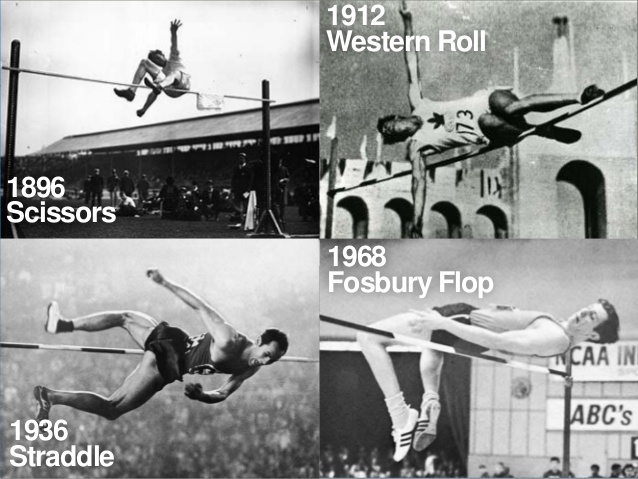“Never give in–never, never, never, never, in nothing great or small, large or petty, never give in except to convictions of honor and good sense. Never yield to force; never yield to the apparently overwhelming might of the enemy.” ― Winston Churchill
“Nothing great or small, large or petty…”
Imagine for a moment, you are sixteen. A High School student and quite tall, no longer a boy but not having reached that level of seasoning and experience, to make you a man. Richard Douglas “Dick” Fosbury found himself at this stage in 1963, sixteen years old and not entirely in control of his own 6-foot, 4-inch frame.
Despite his towering height, young Fosbury failed to make the cut, for basketball. So it was he joined the North Medford High Track & Field team, in Medford Oregon. Fosbury eventually settled on the high jump as his best hope of success. There was only one problem. By his own description, Dick Fosbury was the worst high jumper in North Medford High. Possibly the worst, in all of Oregon.
In track & field, the High Jump is an event in which competitors must clear a horizontal bar, without aid and without dislodging the bar. Rules dictate that the jumper must take off from one foot. There is no rule describing how the jumper, must clear the bar.
Counter-clockwise, from top left: Konstantinos Tsiklitiras during the standing high jump competition at the 1912 Summer Olympics, Platt Adams during the same competition, and Gold medal winner Ethel Catherwood of Canada, scissoring over the bar at the 1928 Summer Olympics. Her winning result was 1.59 m (5 ft 2 1⁄2 in). H/T Wikipedia
Since the earliest such events in mid-19th century Scotland, jumpers have employed a number of methods. There were standing starts and running approaches, both head-on, and diagonal. Jump techniques included everything from a scissoring of the legs to a “straddle technique” to a belly-down “Western Roll”.
Dick Fosbury tried every one of them and then some, and never cleared five-feet. Sometimes he’d start his approach with no idea of what came next, and always the same conclusion. First the collision and then the ignominious descent into the sawdust, with the bar in hot pursuit. Some would stop to chortle, as one humiliating failure followed another. He was “The Fosbury Flop”.
And still, Fosbury labored on.
Then came the day this lanky teenager no one ever heard of, revolutionized his sport. Instead of jumping face forward with the intention of landing on his feet, Fosbury took his leap off the “wrong foot” and hit the bar, backwards. Coaches criticized his unconventional technique. One newspaper called him the “World’s Laziest High Jumper.”
Those who can, Do, those who can’t, Criticize. Right? The kid beat his own best jump that day, by six inches.
Despite the criticism, Fosbury worked on his technique. The other kids still stopped to watch, but no one was chortling, any more.
Oregon State University (Corvallis) track & field coach Berny Wagner insisted that Fosbury stick to the old-school Western Roll technique during practice but left him some leeway, during meets. That debate ended in Fosbury’s sophomore year with a 6-foot, 10-inch jump that destroyed the school record.
Fosbury won the NCAA championship and qualified for the Olympic squad, for the Summer Games of 1968. Then came the Games themselves, the 1968 Summer Olympics, begun October 12 in Mexico city.
Three men had cleared the bar using the old “straddle” technique when a lanky Civil Engineering student from OSU, took to the mat. His shoes were mismatched, his technique so outlandish, newspapers said he looked like a two-legged camel. It was October 20, 1968.
 80,000 spectators witnessed for the first time, the “wrong foot” ascent. The perfect arch. The body mechanics leaving the jumper’s center of gravity, below the bar.
80,000 spectators witnessed for the first time, the “wrong foot” ascent. The perfect arch. The body mechanics leaving the jumper’s center of gravity, below the bar.
At the 2.2 meter mark, only three competitors remained. Fosbury performed the winning leap for the gold medal at 2.24 meters: over 7 & 1/3rd-feet. It was a new Olympic record.
So it was, a gangly kid who once lost a bet he could jump over a chair and broke his hand in the process, came to be the best in the world, at his chosen sport.
Since 1972, the high jump world has adopted the Fosbury Flop, and never looked back. No one is laughing, anymore.
“Nothing in this world can take the place of persistence. Talent will not; nothing is more common than unsuccessful men with talent. Genius will not; unrewarded genius is almost a proverb. Education will not; the world is full of educated derelicts. Persistence and determination alone are omnipotent.” ― Calvin Coolidge






It just goes to show what you can achieve if you buck the trend!
LikeLiked by 1 person
Amen to that, sir.
LikeLiked by 1 person
What a great success story 🙂
LikeLiked by 1 person
I always told my kids, to Never give up. This story hit me in my happy place.😀
LikeLiked by 1 person
Me too- thanks for sharing it 🙂 (Ha, and I was just thinking of watching that video with my kiddos)
LikeLiked by 1 person
❤️
LikeLiked by 1 person
Reblogged this on Dave Loves History.
LikeLiked by 1 person
Thanks buddy. Take care of that knee.
LikeLiked by 1 person